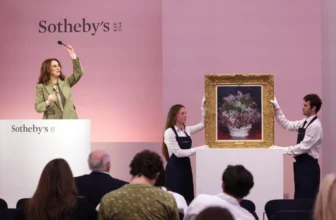
Art as an Asset Class: Comparing Paintings to Stocks and Gold
Is Art a Better Investment
| Invest in Hidden Masterpiece: Rare Antique Oil Paintings For Sale. Limited Originals Available 💰😊 Are you looking for authentic hidden masterpiece? Explore old master antique oil paintings from the Renaissance and Baroque eras. From 16th-century portraits to 18th-century landscapes. Authenticity guaranteed, Old Master antique oil paintings for sale. Shop Now! 🎨 Renaissance And Baroque Art Landscape Antique Paintings Old Master Portrait Paintings |
In recent years, art has emerged not only as a cultural treasure but also as a powerful alternative investment. Wealth managers, hedge funds, and even retail investors are increasingly exploring art as an asset class. From blue-chip masterpieces by Picasso and Basquiat to digital works like NFTs, art investments are reshaping the way people think about wealth diversification.
But how does art compare to traditional assets like stocks and gold? Can a painting really be a more stable store of value, or even outperform the S&P 500? In this detailed guide, we’ll explore the economics of art, its performance history, risks, and how it stacks up against gold and equities as a long-term investment.
Understanding Art as an Asset Class
Art has always been a store of cultural and emotional value, but only recently has it been widely recognized as a legitimate financial asset class. This evolution has been driven by increased transparency, the rise of art investment funds, and digital platforms allowing fractional ownership.
What Defines an Asset Class?
An asset class is a category of investments that behave similarly in the marketplace, with shared characteristics and risk-return profiles. Traditional asset classes include:
Equities (stocks)
Fixed income (bonds)
Commodities (like gold or oil)
Real estate
Cash or cash equivalents
Art fits within the alternative investments category, assets outside traditional markets that often provide diversification benefits because they move independently of stocks and bonds.
Why Art is Considered an Investment
Art, particularly high-value fine art, possesses characteristics that make it appealing to investors:
Scarcity: Each work is unique, and the supply of masterpieces is finite.
Historical value: Many pieces appreciate over time, especially those by renowned artists.
Cultural demand: Art has intrinsic social and cultural appeal, increasing its perceived value.
Hedge potential: Art often performs differently from financial markets, serving as a hedge against inflation or volatility.
How the Art Market Works
Unlike the stock market, the art market is private, fragmented, and opaque. Prices are driven by reputation, provenance, rarity, and market sentiment. Key players include galleries, auction houses (like Christie’s or Sotheby’s), art dealers, and collectors.
Primary vs. Secondary Art Markets
Primary market: Where artworks are sold for the first time, usually by the artist or gallery.
Secondary market: Resales through auctions or private dealers. This is where price appreciation is realized.
Liquidity and Price Discovery
Art lacks daily price quotes like stocks or gold. Transactions are infrequent, and liquidity can be low. Selling a painting can take months or even years, depending on demand. However, platforms like Masterworks and Artex have begun democratizing access by allowing fractional ownership and secondary trading of art shares, improving liquidity.
The Historical Performance of Art
Art has historically delivered solid long-term returns, especially in the post-war and contemporary segments.
Data from the Artprice100 Index
The Artprice100 Index, which tracks the top 100 blue-chip artists, shows an average annual return of around 8–9% over the past two decades. That’s comparable to, and sometimes better than, gold and even the S&P 500, depending on the period analyzed.
Notable Trends
Post-war & contemporary art: Has outperformed older categories due to global demand and media visibility.
Old Masters: Offer stability but lower returns.
Emerging artists: High potential but greater risk, similar to small-cap stocks.
Resilience During Economic Crises
Art tends to hold value better than equities during downturns. For instance:
During the 2008 financial crisis, while the S&P 500 fell 38%, blue-chip art declined only around 4%.
In 2020 (COVID-19 pandemic), art sales slowed due to logistics, but prices for top-tier works remained stable or even rose online.
This resilience suggests art behaves more like a store of value, similar to gold, than a volatile equity.
Comparing Art to Gold
Both art and gold are tangible assets prized for their intrinsic and historical value. Yet, their characteristics differ significantly.
| Factor | Art | Gold |
|---|---|---|
| Liquidity | Low | High |
| Storage/Insurance | Expensive (requires care and security) | Simple and standardized |
| Volatility | Moderate (depends on artist/segment) | Low to moderate |
| Inflation Hedge | Yes | Yes |
| Correlation with Stocks | Low | Low |
| Accessibility | Limited (expertise needed) | Universal |
| Yield/Income | None | None |
| Cultural Value | High | None |
| Entry Barrier | High (though falling with fractional platforms) | Low |
Art vs. Gold as a Store of Value
Gold’s primary role is wealth preservation. It’s universally recognized, liquid, and easy to trade. Art, on the other hand, combines aesthetic enjoyment and potential capital appreciation.
While gold tracks macroeconomic factors like inflation and currency strength, art’s value depends on micro-level dynamics, artist reputation, rarity, and collector demand.
In inflationary environments, both tend to retain value. However, art can outperform when ultra-wealthy buyers seek tangible stores of wealth during currency devaluation or economic uncertainty.
Return Comparison
Gold (2000–2024): ~7% average annual return.
Art (2000–2024): ~8–10% for blue-chip works.
Thus, while gold remains the safer, more liquid asset, art can deliver superior returns with cultural prestige, at the cost of higher transaction friction.
Comparing Art to Stocks
Stocks represent ownership in companies that generate income, while art is a non-productive asset, it doesn’t yield dividends. Yet, art’s performance has often rivaled that of equities over long horizons.
| Factor | Art | Stocks (S&P 500) |
|---|---|---|
| Annual Return (20 yrs) | ~8–9% (blue-chip art) | ~9–10% (including dividends) |
| Volatility | Moderate | High |
| Liquidity | Low | Very high |
| Correlation | Low | High within financial markets |
| Inflation Hedge | Strong | Moderate |
| Ownership Benefits | Aesthetic, social prestige | Income and growth |
| Access via Funds | Art funds, fractional shares | ETFs, mutual funds |
Correlation and Diversification Benefits
Art’s low correlation (0.1–0.2) with the stock market makes it a powerful diversification tool. When equities fall, art prices often remain stable or rise. This is particularly attractive for ultra-high-net-worth individuals (UHNWIs) seeking portfolio balance.
Performance During Volatility
After the 2008 crash, the S&P 500 took five years to recover. Art prices recovered within two years.
During the inflationary periods of the 1970s and 2020s, art values surged as investors sought hard assets.
However, art lacks liquidity and transparency, and its performance can vary widely across artists and segments. Stocks are far easier to value, buy, and sell.
Risk Factors of Investing in Art
While art can yield strong returns, it carries unique risks that differ from financial markets.
1. Illiquidity
Art is notoriously illiquid. Finding a buyer can take months or years, and auctions charge high commissions (10–25%).
2. Valuation Challenges
Unlike stocks, art lacks standardized valuation metrics. Two seemingly similar paintings can differ vastly in price due to subjective factors, artist fame, provenance, or media hype.
3. High Transaction Costs
Auction fees, dealer commissions, storage, insurance, and restoration can eat into returns.
4. Market Concentration
The top 1% of artists dominate the majority of market value. For instance, works by Picasso, Warhol, and Monet alone account for a large share of global art transactions.
5. Forgery and Authenticity Risks
Forgery scandals and disputes over provenance can significantly affect value. Due diligence and expert verification are crucial.
6. No Passive Income
Unlike stocks or bonds, art generates no cash flow. Its return depends solely on appreciation.
The Role of Fractional Art Investing
In the past, art was reserved for billionaires. Today, fractional ownership platforms have democratized access to the art market.
How It Works
Platforms like Masterworks, Yieldstreet, and Artex buy high-value artworks, securitize them, and sell shares to investors. Investors can trade shares on secondary markets, offering liquidity and accessibility.
Advantages
Lower entry cost (from a few hundred dollars)
Exposure to blue-chip art
Portfolio diversification
Transparent data on returns and artist markets
This innovation transforms art from an elite hobby into a structured, investable asset class.
Tax and Regulatory Considerations
Art investing involves unique tax implications:
Capital gains tax: Art is considered a collectible in many countries, often taxed at higher rates than stocks (in the U.S., up to 28%).
Estate planning: Art can be used in trusts or as collateral.
Cross-border trade regulations: Import/export duties and cultural property laws can complicate transactions.
Investors should work with tax advisors and art specialists to optimize ownership structures.
Is Art a Better Investment Than Gold?
The answer depends on your investment goals.
| Aspect | Art | Gold |
|---|---|---|
| Return Potential | Higher (8–10% long-term for blue-chip art) | Moderate (6–7%) |
| Liquidity | Low | High |
| Risk | Medium-High | Low |
| Inflation Hedge | Yes | Strong Yes |
| Accessibility | Moderate | High |
| Tangible/Cultural Value | Exceptional | Minimal |
If your goal is capital preservation and liquidity, gold wins. It’s a universal hedge and easy to convert into cash.
If your goal is wealth growth and prestige, art offers higher upside. Art also holds emotional and aesthetic appeal, something gold lacks.
However, both assets perform well during inflation and financial instability. Many investors hold both to balance liquidity with growth potential.
Is Art a Better Investment Than Stocks?
Comparing art and stocks is like comparing emotion to logic. Stocks represent participation in productive enterprises, while art represents cultural and emotional capital.
When Art Outperforms Stocks
During inflationary or volatile market cycles.
When global wealth among the ultra-rich expands (driving demand).
When cultural trends boost specific artists or movements.
When Stocks Outperform Art
During sustained economic growth cycles.
When corporate earnings and dividends compound.
Due to liquidity, transparency, and compounding power.
Historical performance comparison (2000–2024):
Art: 8–9% annualized
S&P 500: 9–10% annualized (including dividends)
While returns are similar, art’s appeal lies in its diversification, inflation hedging, and aesthetic enjoyment, not necessarily in raw yield. It’s best used as a portfolio complement, not a replacement for equities.
Who Should Invest in Art?
Art investing is suitable for:
High-net-worth individuals (HNWIs) seeking diversification.
Collectors passionate about cultural preservation.
Institutional investors adding alternatives to hedge portfolios.
Retail investors using fractional platforms for exposure.
It’s less suitable for short-term traders or those needing liquidity.
Ideal Portfolio Allocation
Wealth advisors often recommend allocating 1–5% of a diversified portfolio to art or collectibles. This small share can significantly reduce overall portfolio volatility.
Future of Art as an Investment
The art market is evolving rapidly, shaped by technology, transparency, and tokenization.
Emerging Trends
Blockchain Authentication: Reduces forgery risks and improves provenance tracking.
Fractional Art Funds: Increase liquidity and accessibility.
AI-driven Valuation Models: Enhance pricing accuracy using data analytics.
Digital Art and NFTs: Introduce new asset categories tied to blockchain scarcity.
Sustainability and Diversity Focus: Collectors and institutions increasingly value underrepresented artists and eco-conscious practices.
As digitalization progresses, the art market could become as transparent and tradable as mainstream financial markets, further solidifying its position as a recognized asset class.
Key Takeaways: Art vs. Stocks vs. Gold
| Feature | Art | Gold | Stocks |
|---|---|---|---|
| Type | Alternative asset | Commodity | Equity |
| Return Potential | 8–10% (blue-chip) | 6–7% | 9–10% |
| Volatility | Moderate | Low | High |
| Liquidity | Low | High | Very high |
| Inflation Hedge | Strong | Strong | Moderate |
| Correlation with Markets | Low | Low | High |
| Accessibility | Moderate | High | Very high |
| Emotional/Cultural Value | High | None | None |
Art is not inherently “better” or “worse” than gold or stocks, it serves a different function.
Compared to gold, art offers higher returns and cultural enrichment but less liquidity.
Compared to stocks, art offers stability, low correlation, and inflation protection, but no income or liquidity.
Final Thoughts: Should You Invest in Art?
Art has evolved from being a collector’s passion to a serious investment vehicle for diversifying wealth. Historical data shows that blue-chip artworks rival stocks in returns and outperform gold over long periods, while offering a powerful hedge against market volatility and inflation.
However, art is not a quick-profit play. It demands expertise, patience, and a long-term outlook. For most investors, the ideal strategy is to combine art with traditional assets, balancing growth (stocks), safety (gold), and diversification (art).
In an era of uncertainty, owning a piece of timeless creativity is not only a financial strategy but a statement of cultural legacy.
Whether you invest in a Picasso or a fractional share of a Warhol, art as an asset class is proving that beauty, culture, and finance can coexist, and even outperform traditional investments.




